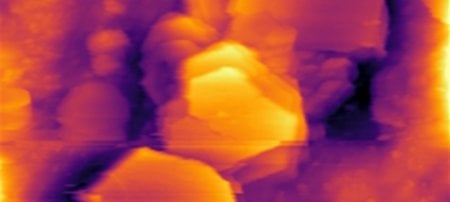Lynn Mazzoleni Leads a Team to Bring a New High-Resolution Spectrometer to Campus

Air is not just air. It’s not just a sterile, preset mix of oxygen, hydrogen, carbon dioxide and other molecules. As an atmospheric chemist, Lynn Mazzoleni knows air is dynamic and full of soot, sulfates, dust and other particles. Now, with a new piece of equipment, she can analyze complex aerosol samples and how their chemistry affects cloud formation.
State-of-the-Art Science: Peatlands to Pharmaceuticals
Mazzoleni is an associate professor of chemistry at Michigan Technological University
and a recent Fulbright Scholar awardee. She is also the lead researcher on a team
that is bringing a high-resolution mass spectrometer to campus through a Major Research
Instrumentation grant from the National Science Foundation (NSF). The instrument is
an analytical chemistry tool that identifies the type and amount of chemicals in a
mixture.
“This will support various environmental and health studies involving very complex mixtures,” Mazzoleni says, adding that her team plans to study everything from atmospheric aerosols to wastewater, infant tears to porewater in peat.
The instrument will be an Orbitrap Elite mass spectrometer with sufficiently high scan rates. The scan rates matter, Mazzoleni says, because getting structural and quantitative data for trace components in complex samples is an intensified version of The Princess and The Pea. Quantitative measurements for such delicate and small molecules require fast chromatography, which is the separation and analysis of mixtures, and minuscule mass measurements in femtograms, or 0.000000000000001 grams.
Interdisciplinary Collaborations for Major Research Instrumentation
Right now, Mazzoleni must travel to the Woods Hole Oceanographic Institution in Massachusetts to run her samples through high-resolution mass spectrometry tests; it’s the only lab that can currently handle her environmental samples. Many biomedical labs have similar equipment, but often these are set up for larger molecules. Even without limited access, the closest facility is six hours south of Michigan Tech. The availability of the Orbitrap Elite on campus will open up new possibilities for a number of researchers, especially those conducting environmental analyses.
“We absolutely need ultrahigh resolving power to see the molecules in extremely complex mixtures in order to learn more about various natural systems, including aquatic systems, terrestrial systems, biological systems and atmospheric aerosols,” Mazzoleni says.
Delving into such complexity requires a large team. In addition to Mazzoleni, the project’s co-investigators include Evan Kane from the School of Forest Resources and Environmental Sciences, Adrienne Minerick, associate dean for research and innovation in the College of Engineering and professor of chemical engineering, and Daisuke Minakata, assistant professor of civil and environmental engineering.
The instrument will be located in Michigan Tech's Great Lakes Research Center, part of its new Microanalytical Facility, a core facility specializing in mass spectrometry equipment. The initiative, and the new Orbitrap Elite instrument, are supported by more than ten institutes and departments across campus.
“This project is a model of the deeply interdisciplinary collaboration that not only characterizes the nature of contemporary science, but which also marks many of the most exciting research activities now underway at Michigan Tech,” says Bruce Seely, dean of the College of Sciences and Arts, adding that Mazzoleni’s efforts to obtain the equipment span more than three years. “This is also a great example of how persistence and determination in the pursuit of external support can pay off for the researchers and the campus at large. I congratulate her and the team for their efforts.”
Student Research
The new equipment also opens doors for students. Annie Putman, a Michigan Tech alumna and current doctoral student at the University of Utah, says her experiences working with Mazzoleni developed her research skills, which have helped her succeed in graduate school.
“The ease of access to measurement lowers barriers to students proposing and completing projects of their own design,” she says, reflecting that her own process involved traveling across the country. Currently Mazzoleni shows videos in class to explain how high-resolution mass spec equipment works.
“Now, students will be able to walk up and see this instrument in action, which is so much better than watching a video on the Internet,” she says, adding, “Having the machine will not only make us more competitive, but actually give us the opportunity to lead new avenues of research in our respective fields.”
Michigan Technological University is an R1 public research university founded in 1885 in Houghton, and is home to nearly 7,500 students from more than 60 countries around the world. Consistently ranked among the best universities in the country for return on investment, Michigan's flagship technological university offers more than 185 undergraduate and graduate degree programs in science and technology, engineering, computing, forestry, business, health professions, humanities, mathematics, social sciences, and the arts. The rural campus is situated just miles from Lake Superior in Michigan's Upper Peninsula, offering year-round opportunities for outdoor adventure.




Comments